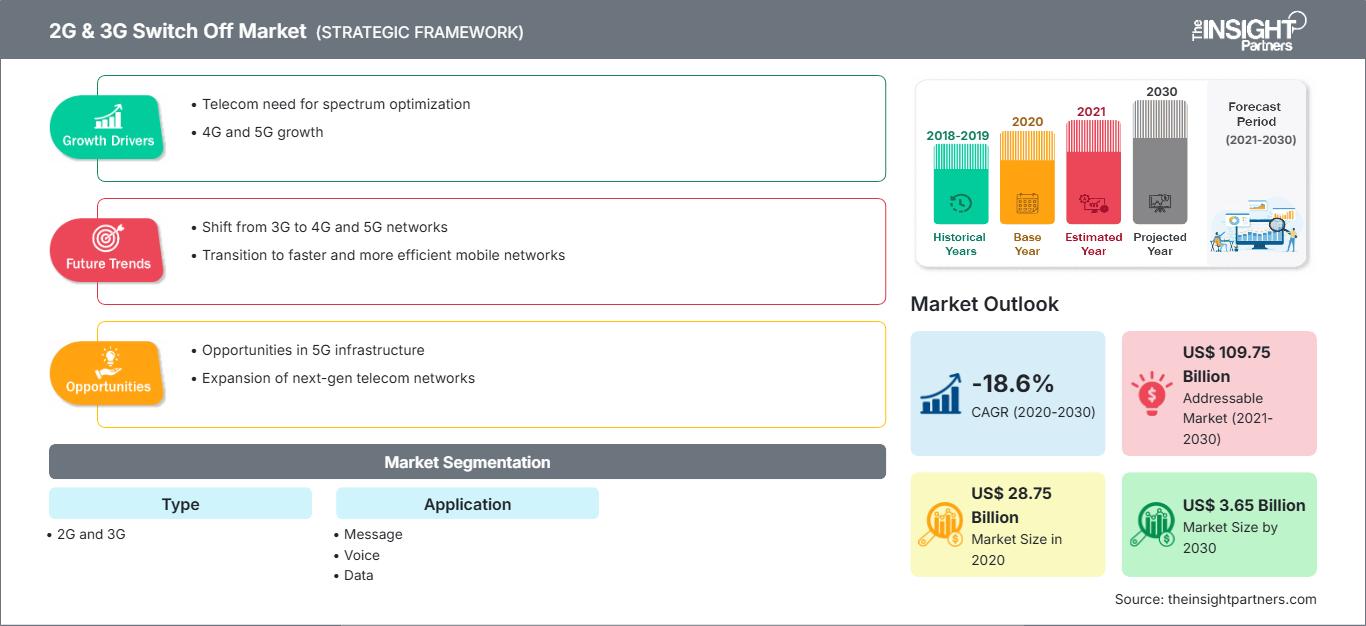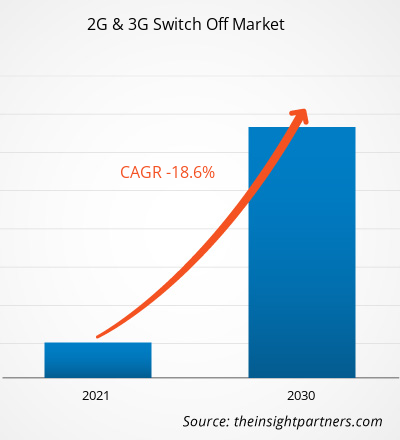[研究报告] 2020 年 2G 和 3G 关断市场规模为 287.5 亿美元,预计到 2030 年将下降至 36.5 亿美元;预计 2020 年至 2030 年的复合年增长率为 -18.6%。
2G 和 3G 关断市场 - 分析师观点:
5G 的快速扩张促使移动网络运营商 (MNO) 关闭其 2G 和 3G 网络,并将其重新用于 5G 部署。这有力地推动了 2G 和 3G 关断市场的增长。许多现有的智能家居设备,例如家庭安全和智能电表,都在 2G 和 3G 网络上进行通信。家庭安全系统通常使用 3G 备用通信器联系监控中心,以应对电源故障或未经授权的电线篡改等事件。 2G 和 3G 更适合物联网和机器对机器 (M2M) 设备,因为它们比 4G 模块更具成本效益。此外,4G 的速度对于发送少量数据的物联网或 M2M 设备来说无关紧要。蜂窝物联网设备始终处于联网状态,其通过移动通信传输数据的能力源于保持永久漫游状态的 M2M 用户识别模块 (SIM) 卡。这使得它们能够利用不同运营商的移动网络,并自主地从一个连接切换到另一个连接,以保持持续连接。因此,速度较慢的 2G 和 3G 连接仍然足以满足当今的标准。因此,2G 和 3G 网络的淘汰会导致依赖 2G 或 3G M2M 用户识别模块 (SIM) 卡的物联网设备的连接选项受限。
预计工业物联网设备将比住宅物联网设备受到更大的影响,因为当前的 5G 部署和未来即将推出的 6G 需要淘汰旧技术。蜂窝连接在工业物联网 (IIoT) 中发挥着重要作用。企业需要在农业、制造业、能源、零售业、医疗保健和物流等垂直行业中,在不同地理区域建立持续连接。当设备持续移动、固定在偏远地区或按需部署时,蜂窝连接至关重要。相比之下,大多数现代智能家居设备通过家庭 Wi-Fi 网络连接。因此,预计 2G 和 3G 的淘汰对智能家居/互联建筑应用的影响微乎其微。例如,英国智能电表的全国推广很大程度上依赖于基于 2G 的 M2M 连接。根据英国政府的统计数据,2022年英国家庭住宅共安装了360万个智能电表,较2021年增长4%。因此,英国的3G网络(预计于2025年完成)将在2G网络(预计于2033年完成)之前关闭,这也推动了2G和3G网络关闭市场的增长。然而,对于全球任何新设备的推出,设备制造商都必须考虑到4G网络在2G和3G网络关闭后不久即将消亡的趋势。例如,Sprint的LTE网络已于2022年6月30日关闭。
自定义此报告以满足您的要求
您将免费获得任何报告的定制,包括本报告的部分内容,或国家级分析、Excel 数据包,以及为初创企业和大学提供超值优惠和折扣
2G和3G关闭市场: 战略洞察

-
获取本报告的主要市场趋势。这个免费样本将包括数据分析,从市场趋势到估计和预测。
2G 和 3G 关闭市场概览:
大量依赖于老一代网络的设备和服务受到了 2G/3G 退网的影响。这些设备和服务包括个人健康报告、家庭安全、工业设备自动化、实时性能和自主操作。这些领域使用的许多设备将持续使用数十年。例如,过去十年生产的许多新车,甚至有些是在 2021 年刚刚推出的,都搭载了基于 3G 的联网服务。这些服务包括位置数据、紧急呼叫服务、Wi-Fi 热点、远程锁定/解锁功能、语音助手、智能手机应用程序连接,甚至礼宾服务。此外,SOS 系统和路边警报等基于网络的功能也可能受到影响。丰田、雷克萨斯、日产和现代在 2019 年之前发布的车辆都容易受到此次退网的影响。
安全系统通常通过蜂窝网络运行。 2016年初,3G网络成为安防面板的标准通信技术。随着传统铜线的淘汰,安防系统开始转向使用蜂窝技术传输信息的无线安防系统。如果已安装的报警系统基于兼容3G的通信器,那么一旦运营商开始淘汰3G网络,无论安防供应商是谁,它都将无法正常工作。在这种情况下,需要更换蜂窝通信器才能在新网络上运行。
全球多家网络运营商已宣布将在2023年前逐步淘汰2G和3G网络,从而推动2G和3G网络切换市场的增长。例如,在这种转变最为明显的欧洲,作为最新加入这一潮流的运营商之一,Orange于2022年8月宣布,将在2025年至2030年期间逐步淘汰传统的2G和3G网络。
2G和3G 关机市场驱动因素:
5G 技术的兴起推动 2G 和 3G 关机市场增长
新兴的 5G 网络比 4G 具有更高的容量、更低的延迟和更大的带宽。这些网络增强功能预计将影响全球人们的工作、生活和娱乐方式。据英特尔公司称,5G 将提供比 4G 高出 1,000 倍的容量,为物联网发展铺平道路。5G 和物联网是绝佳的组合,有可能重塑无线网络和互联网的使用方式。由于能够轻松地与数百或数千台设备通信,城市、工厂、农场、学校和家庭的新应用和用例将蓬勃发展。向 5G 的过渡可能是未来几年智能手机行业最重要的增长引擎。 5G 移动网络的进步实现了低延迟,这为新的机遇开辟了道路,包括虚拟现实体验、多人手机游戏、工厂机器人和自动驾驶汽车应用,而快速响应被视为一项重要标准。因此,由于 5G 技术的巨大优势,许多国家正在采用它,推动了 2G 和 3G 交换机市场的增长。
2G 和 3G 交换机市场细分分析:
2G 和 3G 交换机市场根据类型和应用进行分类。根据类型,2G 和 3G 交换机市场分为 2G 和 3G。3G 细分市场在 2020 年占据了更大的市场份额,而 2G 细分市场正在下降得更快。在应用方面,市场细分为消息、语音、数据和物联网。随着各行各业转向 5G 设备,物联网 (IoT) 领域正以最快的速度减速。按地域划分,2G 和 3G 关停市场分为北美、欧洲、亚太地区 (APAC)、中东和非洲 (MEA) 以及南美 (SAM)。亚太地区采用 5G 的速度最快,2G 和 3G 关停市场下降速度也更快。
运营商正在关闭 2G 和 3G 网络,以释放 4G 和 5G 频段,从而推动 2G 和 3G 关停市场的发展。然而,安装 4G 和 5G 等更高速的网络需要一定的基础设施,包括频谱、站点和光纤;这些基础设施的安装成本相当高昂。部署 5G 基站需要大量的前期成本,包括购买土地或屋顶空间、购买和安装设备、获得许可证以及确保电力供应和回程连接。这些成本对于电信运营商和政府而言都是一个障碍。电信运营商必须参与昂贵的频谱拍卖才能获得 5G 所需的频段。这些拍卖成本会增加整体基础设施支出。
由于 5G 网络的覆盖范围更短且频段更高,因此需要更密集的基站部署。因此,需要更多的基站来覆盖相同的区域,从而增加了基础设施成本。尽管如此,由于 5G 的优势,它正在以惊人的速度被采用,取代了 2G 和 3G 技术。印度、中国、马来西亚、墨西哥、南非和巴西等发展中国家的 5G 用户采用率正在上升,并带动 2G 和 3G 交换机市场增长。
2G 和 3G 交换机市场区域分析:
亚太地区 2G 和2020 年 3G 关机市场规模为 37.1 亿美元,预计到 2030 年将达到 1.1 亿美元;预计 2022 年至 2030 年的复合年增长率为 -29.4%。亚太地区 2G 和 3G 关机市场细分为澳大利亚、印度、中国、日本、韩国和亚太其他地区。据全球技术研究和 IT 咨询公司 ISG 称,预计亚太地区有 29 家运营商将在 2025 年前关闭其 2G/3G 网络。印度计划在 2023 年底前关闭 2G。沃达丰将在 2022 年关闭其 2G,而日本在 2012 年宣布在全国范围内关闭 2G。所有这些例子都促进了 2G 和3G 切换器市场增长。
多家区域运营商正在关闭 2G 和 3G 网络,这对 2G 和 3G 切换器市场的增长产生了积极影响。例如,截至 2021 年 2 月,以“Vi”品牌提供服务的电信运营商 Vodafone Idea Ltd (VIL) 已于 2022 财年全面关闭其在印度所有地区的 3G 服务,并转向 4G。该网络运营商已准备好提供 5G。因此,该地区 2G 和 3G 网络的多次关闭将促进 2G 和 3G 切换器市场的增长。
2G 和3G 关机市场关键参与者分析:
本研究分析了 2G 和 3G 关机市场的主要参与者,包括 AT&T Inc、BCE Inc、中国移动有限公司、德国电信股份公司、KDDI Corp、NTT Data Corp、Orange SA、Telefonica SA、Telenor ASA 和沃达丰集团。此外,本研究还研究和分析了其他几家重要的 2G 和 3G 关机市场参与者,以全面了解全球 2G 和 3G 关机市场及其生态系统。
2G 和 3G 关闭市场区域洞察
The Insight Partners 的分析师已详尽阐述了预测期内影响 2G 和 3G 关机市场的区域趋势和因素。本节还讨论了北美、欧洲、亚太地区、中东和非洲以及南美和中美洲的 2G 和 3G 关机市场细分和地域分布。
2G 和 3G 关闭市场报告范围
| 报告属性 | 细节 |
|---|---|
| 市场规模 2020 | US$ 28.75 Billion |
| 市场规模 2030 | US$ 3.65 Billion |
| 全球复合年增长率 (2020 - 2030) | -18.6% |
| 历史数据 | 2018-2019 |
| 预测期 | 2021-2030 |
| 涵盖的领域 |
By 类型
|
| 覆盖地区和国家 |
北美
|
| 市场领导者和主要公司简介 |
|
2G 和 3G 关闭市场参与者密度:了解其对业务动态的影响
2G 和 3G 关机市场正在快速增长,这得益于终端用户需求的不断增长,而这些需求的驱动因素包括消费者偏好的演变、技术进步以及对产品优势的认知度的提升。随着需求的增长,企业正在扩展其产品线,不断创新以满足消费者需求,并利用新兴趋势,从而进一步推动市场增长。

- 获取 2G和3G关闭市场 主要参与者概述
2G 和 3G 关闭市场最新动态:
- 2023 年 12 月,O2 斯洛伐克宣布计划从 2024 年 1 月开始逐步淘汰其 3G 网络,理由是使用量减少并专注于现代 4G 和 5G 技术。该公司将于 2024 年 1 月底开始关闭斯洛伐克指定区域的 3G 网络,并在未来两年内逐步将关闭范围扩大到全国。O2 指出,由于 4G 和 5G 技术的出现,3G 的使用量已大幅减少,目前已达到最低水平。
- 2023 年 7 月,Singtel、StarHub 和 M1 公布了从 2024 年 7 月 31 日起关闭新加坡 3G 网络的计划,三家公司都将重新利用频谱来改善 5G 服务。两家运营商在一份联合声明中指出,近年来他们一直在敦促 3G 用户迁移到 4G 或 5G 服务,并计划在未来几个月内采取措施帮助用户转向其他网络。
- 历史分析(2 年)、基准年、预测(7 年)及复合年增长率
- PEST和SWOT分析
- 市场规模、价值/数量 - 全球、区域、国家
- 行业和竞争格局
- Excel 数据集
近期报告
客户评价
购买理由
- 明智的决策
- 了解市场动态
- 竞争分析
- 客户洞察
- 市场预测
- 风险规避
- 战略规划
- 投资论证
- 识别新兴市场
- 优化营销策略
- 提升运营效率
- 顺应监管趋势






















 获取免费样品 - 2G和3G关闭市场
获取免费样品 - 2G和3G关闭市场